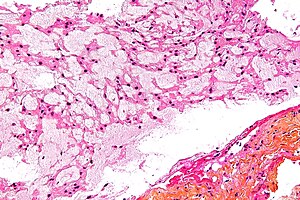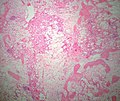Difference between revisions of "Chordoma"
Jump to navigation
Jump to search
(→IHC) |
(wiify) |
||
| (9 intermediate revisions by the same user not shown) | |||
| Line 8: | Line 8: | ||
| LMDDx = [[chondrosarcoma]], [[myxoid lesions]], [[parachordoma]], chordoid lesions (e.g. chordoid glioma, [[chordoid meningioma]]), [[metastasis]] (e.g. [[clear cell renal cell carcinoma]]) | | LMDDx = [[chondrosarcoma]], [[myxoid lesions]], [[parachordoma]], chordoid lesions (e.g. chordoid glioma, [[chordoid meningioma]]), [[metastasis]] (e.g. [[clear cell renal cell carcinoma]]) | ||
| Stains = | | Stains = | ||
| IHC = S-100 +ve, AE1/AE3 +ve, Brachyury +ve, EMA +ve | | IHC = S-100 +ve, [[AE1/AE3]] +ve, Brachyury +ve, [[EMA]] +ve | ||
| EM = | | EM = | ||
| Molecular = | | Molecular = | ||
| Line 34: | Line 34: | ||
*It is a malignant [[bone tumour]] (1-4% of all primary bone tumors). | *It is a malignant [[bone tumour]] (1-4% of all primary bone tumors). | ||
*Usually after age 30. | *Usually after age 30. | ||
===Classification=== | |||
* Chordoma, NOS (ICD-O: 9370/3). | |||
* Chondroid chordoma (ICD-O: 9371/3). | |||
* Dedifferentiated chordoma (ICD-O: 9372/3). | |||
==Gross== | ==Gross== | ||
| Line 73: | Line 74: | ||
===Images=== | ===Images=== | ||
====Case 1==== | |||
<gallery> | <gallery> | ||
Image:Chordoma_-_low_mag.jpg | Chordoma - low mag. (WC) | Image:Chordoma_-_low_mag.jpg | Chordoma - low mag. (WC) | ||
| Line 78: | Line 80: | ||
Image:Chordoma_-_high_mag.jpg | Chordoma - high mag. (WC) | Image:Chordoma_-_high_mag.jpg | Chordoma - high mag. (WC) | ||
Image:Chordoma - very high mag.jpg| Chordoma - very high mag. (WC) | Image:Chordoma - very high mag.jpg| Chordoma - very high mag. (WC) | ||
</gallery> | |||
====Case 2==== | |||
<gallery> | |||
Image: Chordoma -- low mag.jpg | Chordoma - low mag. (WC) | |||
Image: Chordoma -- intermed mag.jpg | Chordoma - intermed. mag. (WC) | |||
Image: Chordoma - alt -- intermed mag.jpg | Chordoma - intermed. mag. (WC) | |||
Image: Chordoma -- high mag.jpg | Chordoma - high mag. (WC) | |||
</gallery> | |||
====Case 3==== | |||
<gallery> | |||
Image:Bone Chordoma 2 HP2.JPG|Physaliphorous cells. (SKB) | Image:Bone Chordoma 2 HP2.JPG|Physaliphorous cells. (SKB) | ||
Image:Bone Chordoma 2 LP PA.JPG|Low power view. Somewhat lobulated tumour with loose areas, cellular areas and fibrous septa. (SKB) | Image:Bone Chordoma 2 LP PA.JPG|Low power view. Somewhat lobulated tumour with loose areas, cellular areas and fibrous septa. (SKB) | ||
| Line 85: | Line 97: | ||
Image:Bone Chordoma HP PA.JPG|Chordoma cells may form sheets of cells with eosinophilic cytoplasm. (SKB) | Image:Bone Chordoma HP PA.JPG|Chordoma cells may form sheets of cells with eosinophilic cytoplasm. (SKB) | ||
</gallery> | </gallery> | ||
www | ====www==== | ||
*[http://path.upmc.edu/cases/case64.html Chordoma (upmc.edu)]. | *[http://path.upmc.edu/cases/case64.html Chordoma (upmc.edu)]. | ||
*[http://path.upmc.edu/cases/case312/micro.html Chordoma - sacrum - several images (upmc.edu)]. | *[http://path.upmc.edu/cases/case312/micro.html Chordoma - sacrum - several images (upmc.edu)]. | ||
| Line 92: | Line 104: | ||
==IHC== | ==IHC== | ||
Features:<ref>URL: [http://path.upmc.edu/cases/case312/micro.html http://path.upmc.edu/cases/case312/micro.html]. Accessed on: 14 January 2012.</ref><ref name=pmid2431128>{{Cite journal | last1 = Coindre | first1 = JM. | last2 = Rivel | first2 = J. | last3 = Trojani | first3 = M. | last4 = De Mascarel | first4 = I. | last5 = De Mascarel | first5 = A. | title = Immunohistological study in chordomas. | journal = J Pathol | volume = 150 | issue = 1 | pages = 61-3 | month = Sep | year = 1986 | doi = 10.1002/path.1711500110 | PMID = 2431128 }}</ref> | Features:<ref>URL: [http://path.upmc.edu/cases/case312/micro.html http://path.upmc.edu/cases/case312/micro.html]. Accessed on: 14 January 2012.</ref><ref name=pmid2431128>{{Cite journal | last1 = Coindre | first1 = JM. | last2 = Rivel | first2 = J. | last3 = Trojani | first3 = M. | last4 = De Mascarel | first4 = I. | last5 = De Mascarel | first5 = A. | title = Immunohistological study in chordomas. | journal = J Pathol | volume = 150 | issue = 1 | pages = 61-3 | month = Sep | year = 1986 | doi = 10.1002/path.1711500110 | PMID = 2431128 }}</ref> | ||
*S-100 +ve. | *S-100 +ve - '''important'''. | ||
*AE1/AE3 +ve. | *[[AE1/AE3]] +ve - '''important'''. | ||
*Brachyury +ve | *Brachyury +ve - '''key stain'''. | ||
**Protein important for axial development, affects notochord development.<ref name=omim601397>{{OMIM|601397}}</ref> | **Protein important for axial development, affects notochord development.<ref name=omim601397>{{OMIM|601397}}</ref> | ||
**''Brachyury'' literally means ''short tail''.<ref>URL: [http://www.jstor.org/pss/86845 http://www.jstor.org/pss/86845]. Accessed on: 18 May 2010.</ref> | **''Brachyury'' literally means ''short tail''.<ref>URL: [http://www.jstor.org/pss/86845 http://www.jstor.org/pss/86845]. Accessed on: 18 May 2010.</ref> | ||
*EMA +ve. | *[[EMA]] +ve. | ||
* | *[[PAX8]] -ve (1 +ve (weak) of 12.<ref name=pmid21102418>{{Cite journal | last1 = Sangoi | first1 = AR. | last2 = Karamchandani | first2 = J. | last3 = Lane | first3 = B. | last4 = Higgins | first4 = JP. | last5 = Rouse | first5 = RV. | last6 = Brooks | first6 = JD. | last7 = McKenney | first7 = JK. | title = Specificity of brachyury in the distinction of chordoma from clear cell renal cell carcinoma and germ cell tumors: a study of 305 cases. | journal = Mod Pathol | volume = 24 | issue = 3 | pages = 425-9 | month = Mar | year = 2011 | doi = 10.1038/modpathol.2010.196 | PMID = 21102418 }}</ref>). | ||
*Other keratins:<ref name=pmid9195570>{{Cite journal | last1 = Naka | first1 = T. | last2 = Iwamoto | first2 = Y. | last3 = Shinohara | first3 = N. | last4 = Chuman | first4 = H. | last5 = Fukui | first5 = M. | last6 = Tsuneyoshi | first6 = M. | title = Cytokeratin subtyping in chordomas and the fetal notochord: an immunohistochemical analysis of aberrant expression. | journal = Mod Pathol | volume = 10 | issue = 6 | pages = 545-51 | month = Jun | year = 1997 | doi = | PMID = 9195570 }}</ref> | |||
**CK8 +ve (16/16). | **CK8 +ve (16/16). | ||
**CK19 +ve (16/16). | **CK19 +ve (16/16). | ||
**CK18 +ve/-ve (9 +ve/16). | **CK18 +ve/-ve (9 +ve/16). | ||
**CK7 -ve (1 +ve/16). | **[[CK7]] -ve (1 +ve/16). | ||
**CK20 -ve (0 +ve/16). | **[[CK20]] -ve (0 +ve/16). | ||
Classic chordoma panel:<ref name=pmid24296480>{{Cite journal | last1 = Shen | first1 = J. | last2 = Shi | first2 = Q. | last3 = Lu | first3 = J. | last4 = Wang | first4 = DL. | last5 = Zou | first5 = TM. | last6 = Yang | first6 = HL. | last7 = Zhu | first7 = GQ. | title = Histological study of chordoma origin from fetal notochordal cell rests. | journal = Spine (Phila Pa 1976) | volume = 38 | issue = 25 | pages = 2165-70 | month = Dec | year = 2013 | doi = 10.1097/BRS.0000000000000010 | PMID = 24296480 }}</ref> | |||
*EMA, AE1/AE3, CAM5.2, vimentin, S-100. | |||
Key points: | Key points: | ||
*Brachyury is not a commonly stocked antibody. | *Brachyury is not a commonly stocked antibody. | ||
*Chordoma will be S100 ''' | *Chordoma will be S100 '''''and''''' epithelial marker positive. | ||
*Many other items in the | *Many other items in the DDx will be either S100 '''''or''''' epithelial marker positive. | ||
==See also== | ==See also== | ||
*[[CNS tumours]]. | *[[CNS tumours]]. | ||
*[[Parachordoma]]. | |||
==References== | ==References== | ||
Latest revision as of 19:36, 31 July 2016
| Chordoma | |
|---|---|
| Diagnosis in short | |
 Chordoma. HPS stain. | |
|
| |
| LM | physaliphorous cells (also bubble cells) - very large clear bubble with a sharp border, bubble does not compress nucleus; islands of cells surrounded by fibrous tissue; myxoid background |
| LM DDx | chondrosarcoma, myxoid lesions, parachordoma, chordoid lesions (e.g. chordoid glioma, chordoid meningioma), metastasis (e.g. clear cell renal cell carcinoma) |
| IHC | S-100 +ve, AE1/AE3 +ve, Brachyury +ve, EMA +ve |
| Gross | myxoid |
| Site | sacrum or clivus |
|
| |
| Prevalence | uncommon |
Chordoma is an uncommon tumour in neuropathology.
General
- Location: usually sacrum or clivus.
- It is a malignant bone tumour (1-4% of all primary bone tumors).
- Usually after age 30.
Classification
- Chordoma, NOS (ICD-O: 9370/3).
- Chondroid chordoma (ICD-O: 9371/3).
- Dedifferentiated chordoma (ICD-O: 9372/3).
Gross
- Soft, gelatinous, lobulated.[1]
DDx:
- Bony metastasis (mucinous carcinoma) - typically multifocal.
Image:
Microscopic
Features:[2]
- Architecture: islands of cells surrounded by fibrous tissue.
- Also described as "lobulated" architecture; may not be apparent.
- Myxoid background - grey extracellular material, variable amount present.
- Mixed cell population:
- Abundant eosinophilic cytoplasm.
- Physaliphorous cells or bubble cells - key feature.
- Have a very large clear bubble with a sharp border; bubble does not compress nucleus - nucleus may be in bubble.
DDx:
- Chondrosarcoma - negative for EMA and cytokeratins. Beware of 'chondroid' chordoma.
- Myxoid lesions.
- Myxopapillary ependymoma.
- Myxoid liposarcoma - negative for EMA and cytokeratins.
- Chordoid lesions.
- Chordoid meningioma.
- Chordoid glioma[3] - location, location, location.
- Large notochordal rest - only evidence of destructive growth can identify a chordoma.
- Metastasis.
- Metastatic signet ring cell carcinoma - negative for S100 and brachyury, clinical history (important).
- Metastatic clear cell renal cell carcinoma - negative for S100 and brachyury, clinical history (important).
- Parachordoma - extremely rare.
Images
Case 1
Case 2
Case 3
www
- Chordoma (upmc.edu).
- Chordoma - sacrum - several images (upmc.edu).
- Chordoma - additional case with several images (upmc.edu).
IHC
- S-100 +ve - important.
- AE1/AE3 +ve - important.
- Brachyury +ve - key stain.
- EMA +ve.
- PAX8 -ve (1 +ve (weak) of 12.[8]).
- Other keratins:[9]
Classic chordoma panel:[10]
- EMA, AE1/AE3, CAM5.2, vimentin, S-100.
Key points:
- Brachyury is not a commonly stocked antibody.
- Chordoma will be S100 and epithelial marker positive.
- Many other items in the DDx will be either S100 or epithelial marker positive.
See also
References
- ↑ URL: http://www.histopathology-india.net/Chordoma.htm. Accessed on: 12 April 2012.
- ↑ Tadrous, Paul.J. Diagnostic Criteria Handbook in Histopathology: A Surgical Pathology Vade Mecum (1st ed.). Wiley. pp. 184. ISBN 978-0470519035.
- ↑ Zarghouni, M.; Vandergriff, C.; Layton, KF.; McGowan, JB.; Coimbra, C.; Bhakti, A.; Opatowsky, MJ. (Jul 2012). "Chordoid glioma of the third ventricle.". Proc (Bayl Univ Med Cent) 25 (3): 285-6. PMID 22754136.
- ↑ URL: http://path.upmc.edu/cases/case312/micro.html. Accessed on: 14 January 2012.
- ↑ Coindre, JM.; Rivel, J.; Trojani, M.; De Mascarel, I.; De Mascarel, A. (Sep 1986). "Immunohistological study in chordomas.". J Pathol 150 (1): 61-3. doi:10.1002/path.1711500110. PMID 2431128.
- ↑ Online 'Mendelian Inheritance in Man' (OMIM) 601397
- ↑ URL: http://www.jstor.org/pss/86845. Accessed on: 18 May 2010.
- ↑ Sangoi, AR.; Karamchandani, J.; Lane, B.; Higgins, JP.; Rouse, RV.; Brooks, JD.; McKenney, JK. (Mar 2011). "Specificity of brachyury in the distinction of chordoma from clear cell renal cell carcinoma and germ cell tumors: a study of 305 cases.". Mod Pathol 24 (3): 425-9. doi:10.1038/modpathol.2010.196. PMID 21102418.
- ↑ Naka, T.; Iwamoto, Y.; Shinohara, N.; Chuman, H.; Fukui, M.; Tsuneyoshi, M. (Jun 1997). "Cytokeratin subtyping in chordomas and the fetal notochord: an immunohistochemical analysis of aberrant expression.". Mod Pathol 10 (6): 545-51. PMID 9195570.
- ↑ Shen, J.; Shi, Q.; Lu, J.; Wang, DL.; Zou, TM.; Yang, HL.; Zhu, GQ. (Dec 2013). "Histological study of chordoma origin from fetal notochordal cell rests.". Spine (Phila Pa 1976) 38 (25): 2165-70. doi:10.1097/BRS.0000000000000010. PMID 24296480.













